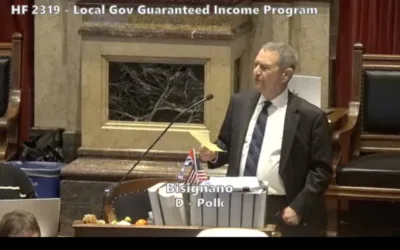
Gas prices have been top-of-mind for many Americans, especially because they’re higher than they’ve been for 14 years.
As of Monday, the average price for a regular gallon of gas in Iowa is $3.854. This is the highest a gallon of gas has been here since significant spikes in 2012 and another spike in the mid-to-late 2000s.
Over the last eight years, Iowa’s gas prices have hovered in the mid-to-high $2-a-gallon range on average, but prices are rising because of inflation, corporate price-gouging, and other factors.
There’s a lot of confusion about how and why gas prices go up, why they go up so much, and who’s responsible.
Gas is one of the most complicated products to price, so…
OK, whatever, why is gas so high?
Um, hi. Well. Simply, because it’s complicated.
More complicated: because oil companies are taking advantage of global chaos.
More detailed is that gas prices are set by a few things: crude oil prices, taxes, refining costs, and distribution. But crude oil price is the biggest individual factor, making up just over 50% of the cost.
When the price of oil goes up, the other factors remain steady, so it results in a larger increase in the retail price of gas.
[inline-ad id=”1″]
Wait, how much is crude oil then?
As of Friday, crude oil is more than $100 a barrel, according to the US Energy Information Administration (EIA).
So that’s why prices are high?
Well…
It’s also a question of supply and demand. Though supply is improving in the US, it’s still below pre-pandemic levels.
And that’s President Biden’s fault, right?
No, that’s definitely not part of the answer.
Presidents don’t set gas prices in the same way they don’t set any other prices, because oil companies are private businesses. Besides, oil prices are determined by a global market.
[inline-ad id=”2″]
But gas prices are higher now that he’s president.
And several things have happened since he became president. The big one is Russian President Vladimir Putin decided to invade Ukraine.
Sanctions on Russia are limiting the amount it can export. Russia is a major world oil exporter (read: supplier), and demand hasn’t changed. So, less supply but high demand equals high prices.
But, it did invade a sovereign nation and is currently killing Ukrainian citizens, so stopping that is a really good reason for keeping sanctions in place. Sanctions that passed with broad bipartisan support.
[inline-ad id=”3″]
But—
And the US isn’t even paying the most at the pump. Australians are paying $5.38 a gallon, Canadians are paying $5.94 a gallon, Germans are paying $9.12 gallon, and people in Hong Kong are paying $10.90 a gallon. Americans are right in the middle.
Also, Russian oil only makes up 2-3% of America’s oil imports anyway. Prices were also rising before the invasion, so there’s more going on.
Right, OK why aren’t we producing more then?
Well, we’re already producing a lot. America is actually a leading global supplier. And US oil production has increased over the past couple of years. Early data from the EIA show the US produced an average of 11.185 million barrels of crude oil a day in 2021. And that trend is supposed to keep going: The EIA estimated the US will average 12.4 million barrels a day in 2023.
For some context, during former-President Donald Trump’s first year, the US was producing about 9 million barrels a day.
[inline-ad id=”4″]
But Biden shut down oil drilling! And what about the Keystone XL Pipeline?
Oh no. None of that is true, much to the chagrin of climate activists.
Biden has tried to halt new drilling on federal land but a federal judge struck down his pause. Then the administration held an auction of drilling leases around the Gulf of Mexico. Those were paused because another federal judge blocked the administration from considering costs to the climate when auctioning those leases.
Also, the Keystone Pipeline isn’t a factor because we get Canadian oil by rail, and the pipeline wouldn’t be operating at this point anyway. So we’re still getting the oil, it’s just coming from other pipelines. To boot, Canadian oil still makes up about half our oil imports.
Also, note that the company behind the Keystone Pipeline said it’s dead too.
[inline-ad id=”5″]
So why is there a supply problem?
Russian invasion, and right now about half of the leased land for drilling isn’t being used. That’s the case for a number of reasons. If you want to know more, here’s an article from the Poynter Institute.
But basically, producers can’t start drilling right away once they have a permit.
It’s also generally more expensive to drill domestically. And finally, corporate shenanigans. They can get more money from investors by having proven reserves, there’s industry pressure to use the money to pay more in dividends. Oil companies can also play mind games with each other based on how many leases they have.
This isn’t abnormal, new, or unique to Biden’s presidency, but it is a factor.
So oil companies just aren’t producing as much?
Pretty much. Remember when I mentioned companies taking advantage of chaos? First, it was the pandemic, now it’s war.
Yes, oil demand suffered a big blow in early 2020 because of the pandemic, but it’s back up! Oil companies are reporting massive profits, which they would like to continue doing.
According to Dr. Mark Zandi, chief economist at Moody’s Analytics and director for their economic research, oil companies start to make a profit when the prices are as low as $60-65 per barrel. So they’re not hurting.
“Combined, the four companies raked in $24.4 billion in quarter four of 2021, bringing their total profits for last year to over $75.5 billion. Chevron, Shell, BP, and Exxon used these bloated profits to shower billions onto their shareholders—including their wealthy executives whose salaries are heavily padded with stocks,” reported the watchdog group Accountability.US. “In 2021, the four companies bought back over $6.6 billion in stocks while hiking up their dividends. And the oil giants are planning for an ‘even better’ 2022 for shareholders, with plans already in place to buy back over $22 billion in stock thanks to high oil prices.”
[inline-ad id=”1″]
So…it’s all about money then.
Yes. If you have to fill your gas tank to live your life, you really have to pay whatever the gas station says.
But why?
Because enough people blame the government for gas prices (and inflation) and oil company lobbyists latch onto that to avoid regulations or restrictions. Politicians won’t take them on because a lot of them get money from oil, and oil companies would just turn around and point at the government as the root of all the problems.
Huh.
I know.
by Nikoel Hytrek
03/21/22
Iowa Starting Line is part of an independent news network and focuses on how state and national decisions impact Iowans’ daily lives. We rely on your financial support to keep our stories free for all to read. You can contribute to us here. Also follow us on Facebook and Twitter.
[inline-ad id=”0″]
Support Our Cause
Thank you for taking the time to read our work. Before you go, we hope you'll consider supporting our values-driven journalism, which has always strived to make clear what's really at stake for Iowans and our future.
Since day one, our goal here at Iowa Starting Line has always been to empower people across the state with fact-based news and information. We believe that when people are armed with knowledge about what's happening in their local, state, and federal governments—including who is working on their behalf and who is actively trying to block efforts aimed at improving the daily lives of Iowan families—they will be inspired to become civically engaged.


Iowa Republicans make outlawing gay marriage key 2024 campaign priority
Iowa Republicans have made outlawing gay marriage a key goal in their 2024 party platform. During the Iowa GOP’s 2024 state convention on Saturday,...

Department of Justice says Iowa immigration law violates US Constitution
If Iowa doesn’t suspend the enforcement of its new immigration law by May 7, the state could face a federal lawsuit, according to the Des Moines...

Rushing: Iowa State president said the quiet part out loud
I want to thank Iowa State University President Wendy Wintersteen for doing us all a favor by finally saying the quiet part out loud: all the...

Iowa sets aside almost $180 million for year two of voucher program
Iowa has committed nearly $180 million in taxpayer funds to support private school tuition in the 2024-25 school year, which is almost $50 million...

Kalbach: Immediate action needed on corporate ag pollution
Iowa agriculture has undergone substantial changes over the past 40 years. We see it all around us. Rather than crops and livestock being raised on...

VIDEO: Jochum calls Gov. Reynolds’ summer meal program a ‘hunger game’
Iowa Gov. Reynolds announced a competitive $900,000 grant program to feed Iowa children over the summer, months after she declined $29 million in...





